Birds
Highlights
Terns & Gulls
A Little Tern was an excellent discovery at Grimsbury reservoir on the 12th albeit a brief one. Seven Arctic Terns stopped off at Farmoor en route to their breeding sites on the 5th. Further birds noted at the Oxford reservoir on the 7th and the 27th, a further four on the 28th and a single bird was seen briefly at Grimsbury Res on the 12th.
Raptors
Waterfowl
Waders
Passerines
A Quail was heard on the Downs near Blewbury on the 30th and near Aston Upthorpe on the 31st, will this be a good Quail year?
Some call him 'Long Shanks of the Downs'... some 'Watcher of the Outlands' but
to most of us he's Mark Merritt and in May he smashed 200 for Oxon so congrats mate.
Media Production Assistant
Wildfowl & Wetlands Trust (WWT) Slimbridge, Glos GL2 7BT, UK
T 01453 891 123
E sam.stafford@wwt.org.uk
W wwt.org.uk


- Farmoor Reservoir: 4th June
Ringed Plover today at Farmoor courtesy of Jim Hutchins ...
- Otmoor.a.m. 16th October.
Bittern (per John Reynolds) ...
- Redwings 14th October
Courtesy of Paul Chandler more at Cholsey Wildlife Redwing 120 Middleton Cheney (M.H) ...
- Otmoor 22nd September
Hen Harrier (ringtail) Ashgrave 17:20 Then over the reed beds 17:40 & 18:40 ...
- Otmoor. Evening.
Shelduck. (juv.)From the Bridleway. Marsh Harrier. 1 Hobby (per Joe...
Birds
May Highlights
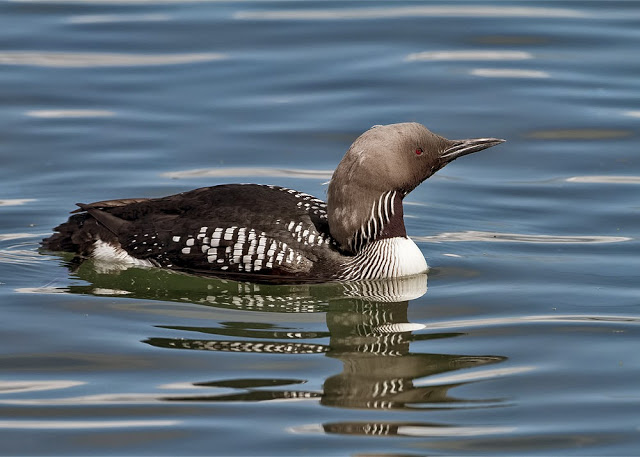 |
| Black-throated Diver Farmoor Reservoir courtesy of Derek Lees |
Highlights
So May has come and gone and we are now into the fag-end of spring. But did it live up to its reputation as the best month of the first half of the year if not the whole year? Well, granted there were some good birds but somehow, to us at least, it felt like it never quite delivered with many of the headline birds sadly being untwitchable.
There's no doubt about the headline bird this month: a cracking Red-necked Phalarope was discovered at the Banbury Ornithological Societies Bicester Wetlands reserve on the 24th by reserve warden Alan Peters. Initially found at 2:30 pm, it obliged by staying put all day allowing the great and the good of Oxon county birding to come to pay homage. It was a much-needed county tick for almost everyone in the lower half of the county listing table and even a few of the upper echelons still needed it. This very much made up for the untwitchable one that turned up at Balscote Quarry in June last year but like that bird sadly there was no sign of it next morning. This is a real county Mega with the last record being a two day bird in September 1995. We are sure that we speak for all those who caught up with this splendid little bird in thanking the reserve warden Alan Peters for allowing access to the reserve and hides throughout Sunday.
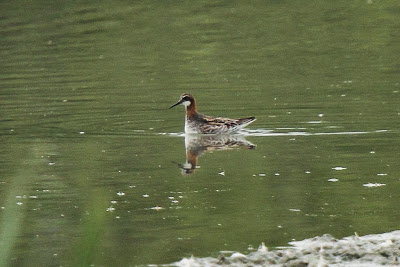 |
| Male Red-necked Phalarope courtesy of Wayne Bull |
Red-necked Phalarope courtesy of Paul Wren
A stunning summer plumaged Black-throated Diver dropped in to Farmoor reservoir on the morning of the 14th and offered some superb photographic opportunities often at point-blank range. Sadly, as it hung around it soon became apparent that it had picked up an injury and wasn't well. A valiant attempt by Tiggywinkles wildlife hospital to take it into care on the 19th unfortunately failed and the Diver was later found dead on the 23rd, a very sad end for such a magical and beguiling bird.
One of the best records of the month, namely a Black Kite on the 4th May near Begbroke is relegated to third position in the highlights as sadly it was an untwitchable single-observer record. Black Kite is real county Mega but fortunately good photos were obtained of the bird so there is no doubt about this record. If only it had stuck around!
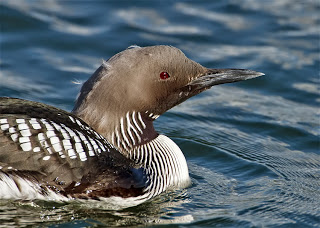 |
| courtesy of Derek Lees |
| Black Kite courtesy of Simon Dowell |
Also in the untwitchable category was a heard-only Bee-eater over the Pinkhill reserve adjacent to Farmoor reservoir on the 9th and yet another untwitchable record was an unseasonal Arctic Skua which called in to Farmoor briefly on the 19th. It hung around for just a few minutes before heading off again and appeared to follow the Thames.
Three Cranes from the Slimbridge Release Scheme (see below for details) flew over the Bicester Wetlands Reserve on the 9th before heading east over Otmoor and then Gallows Bridge, Bucks and a few days later on into Hampshire. The two Cranes from April were still to be seen albeit sporadically on Otmoor over the first half of May
Terns & Gulls
A Little Tern was an excellent discovery at Grimsbury reservoir on the 12th albeit a brief one. Seven Arctic Terns stopped off at Farmoor en route to their breeding sites on the 5th. Further birds noted at the Oxford reservoir on the 7th and the 27th, a further four on the 28th and a single bird was seen briefly at Grimsbury Res on the 12th.
Black Terns were again low in numbers for a second consecutive spring with three at Farmoor on the 2nd and a single bird on the 11th
Always a pleasure to see, several Little Gulls were at Farmoor at the start of the month with six birds
over Kingston Bagpuize on the 19thRaptors
A late Osprey was seen flying up the Thames at Shillingford on the 25th. Two Marsh Harriers remained on Otmoor until the months end with up to ten Hobby also at the RSPB reserve. Singles were also seen at Bladon Heath, Wantage,Kingston Bagpuize,Grimsbury reservoir and Abingdon.
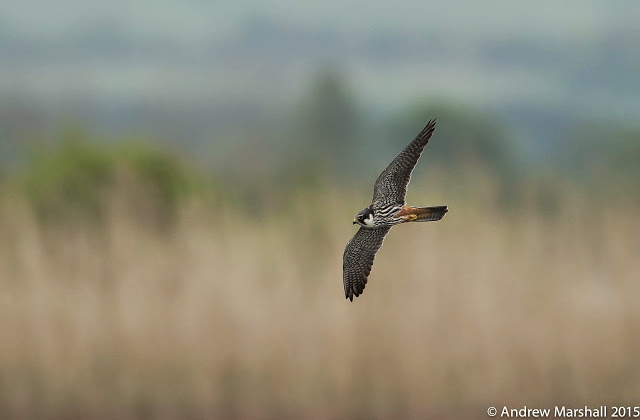 |
| Hobby over Otmoor |
Waterfowl
A late Bittern was reported at Otmoor on the 8th and a splendid male Garganey graced the Otmoor marshes from the 2nd-4th.
Waders
There was a smattering of Bar-tailed Godwit records this month with birds seen at Farmoor reservoir on the 1st and the 9th with up to five of the more common Black-tailed Godwits arriving at Otmoor on the 2nd accompanied by two Ruff. Three Black-wits were also to be seen at Balscote Quarry on the 9th.
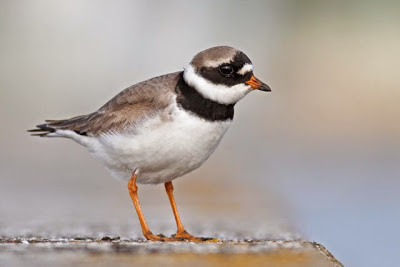 |
| Ringed Plover courtesy of Steve Burch |
A pair of Oystercatchers at Grimsbury reservoir on the 6th was a welcome discovery. Six Turnstones constituted the highest Oxon count for the month but a single bird on Big Otmoor on the 7th was a notable record of this species away from Farmoor and at this site. Sanderling kept arriving throughout May with up to five birds at Farmoor on the 3rd and eleven on the 30th.
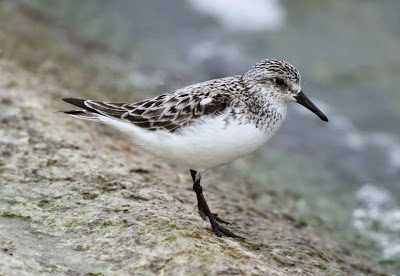 |
| Sanderling courtesy of Jon Mercer |
There were nine Dunlin at Farmoor on the 9th with numbers reaching twenty nine on the 9th. The five Ringed Plover on Otmoor on the 21st had increased to seven by the 30th and were the highest count for May. Whimbrel migrated through Oxfordshire on the 3rd,4th and 19th at Farmoor and at Rushy Common on the 16th. For a second consecutive year it has been a poor spring for Wood Sandpipers with no known records in the county.
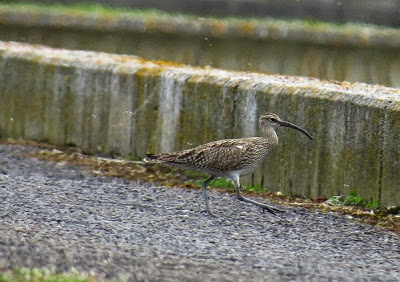 |
| Whimbrel at Farmoor courtesy of Alan Horsley |
Passerines
The first of up to four Turtle Doves arrived safely back at on the RSPB Otmoor reserve from the 5th and rightly drew admirers from far and wide. Unfortunately one of the birds seemed to have a small pellet hole in one of its wings and although it does not seem to hinder it, it brings home the perils these beautiful little doves face each year in getting to us. Two Turtle Doves were seen at Souldern near Bicester on the 18th with a single bird making a very welcome addition to a Duxford garden list on the 29th.
| Turtle Doves on Otmoor courtesy of Jim Hutchins |
Cuckoos were (by recent standards) well represented in the county with birds returning to Stanton St.John, Henley Road gravel pits and Otmoor on the 1st, singles also arrived at Cholsey Marsh on the
2nd.
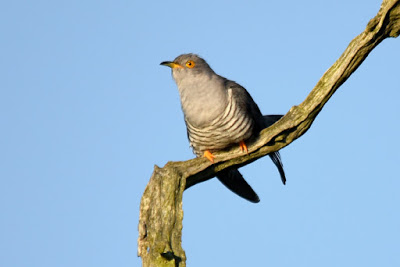 |
| Cuckoo on Otmoor courtesy of Moth Clark |
A Nightingale was heard singing in the early hours from the M.O.D land at Arncott from the 7th-11th with another songster somewhat more unexpectedly along Salt Lane in Banbury on the 10th-11th.
A Blue-headed Wagtail flava stopped off at Farmoor reservoir briefly around the 3rd.
At least two Grasshopper Warblers set up territories in Hanwell Fields to the north of the county from the 3rd with up to three birds reeling from their more traditional sites at Otmoor. Singles were also seen or heard near Sandford-on-Thames.
Whinchats were at Balscote Quarry and Grove Airfield on the 7th and at Chimney Meadows on the 17th with a late individual also noted at Otmoor on the 20th.
Following on from last months Ring Ouzel bonanza a male was at the B.O.S Tadmarton reserve on the 16th.
A Quail was heard on the Downs near Blewbury on the 30th and near Aston Upthorpe on the 31st, will this be a good Quail year?
OX Club
Club
Some call him 'Long Shanks of the Downs'... some 'Watcher of the Outlands' but
to most of us he's Mark Merritt and in May he smashed 200 for Oxon so congrats mate.
Slimbridge Release Scheme Cranes
| Cranes over Bicester Wetlands Reserve courtesy of Nick Truby |
The three Bicester Cranes were from the Slimbridge Release Scheme. From left to right we have: Skye, Oakie & Cotton. If you’re interested you can use the Great Crane Project’s website to identify the cranes. You can also read the latest Wildlife Weekly from WWT Slimbridge featuring cranes.
Sam Samuel StaffordMedia Production Assistant
Wildfowl & Wetlands Trust (WWT) Slimbridge, Glos GL2 7BT, UK
T 01453 891 123
E sam.stafford@wwt.org.uk
Coming in from the Cold
by Adam "Gnome" Hartley

Whilst some people have been birders all their lives, some come to it later in life. Others still start off birding and then drift off into other pursuits - the "wilderness years", until something brings them back to it. I fall very much into the latter category and this is the tale of how I came back into the fold. In hindsight, it was a combination of a number of factors which on their own wouldn't have brought me back but taken together were enough to bring me in from the cold.

I remember as a boy getting interested in birds. Someone had bought me four RSPB posters of the commoner birds in various habitats for a present and I used the garden one to get to know the commonest birds. I discovered that I enjoyed this identification process and got a bit more interested. Gradually I progressed to the Observer Book of Birds (which was fairly useless in hindsight) and then to the Birds of Britain and Europe (I forget who published that). I joined the Young Ornithologist's Club (the RSPB youth wing) and went on a few local trips and I was hooked. Then as I grew into a teenager I got into other interests. I'd like to say that it was drink and girls though it was actually more like fishing, bridge, Dungeons & Dragons and computer programming. It's only here amongst birders that I feel that I can comfortably confess to such interests - after fellow birders are hardly likely to accuse me of being too nerdy! I went off to University and whilst I kept up the fishing sporadically the birding had long since fallen by the wayside.
Time passed, I met my VLW and we settled down here in Oxford, first in Marston and then we bought a house in Walton Manor, near Port Meadow as it happens. In the summer of 2007 we went on a family holiday up to Sutherland (north west Scotland) - one of the last true wildernesses in Europe apparently, it was wonderfully remote. Without particularly trying we came across some interesting bird life up there with breeding Black-throated Divers calling on Loch Stack, a view of a Merlin hunting along the road as we drove by, Ring Ouzels on Ben Stack and a flock of twenty Ptarmigan that we stumbled across on top of Arckle, a rather harsh, almost lunar-landscaped mountain in the region. Seeing these birds piqued my interest and brought back childhood memories of seeing pictures of these birds in my bird books and wondering if I would ever actually see them. Without realising it at the time, this gave me a nudge in the direction of birding.
 |
| On top of Arckle - photo taken from the internet |
A few week later, during one of my periodic attempts to get fit I was going for a run on the Meadow which I remember was unusually flooded all year. I remember running along the path by the flood water and seeing at least a dozen long-legged white heron-like birds there on the floods. I stopped and stared! Surely those were Egrets - something that was incredibly rare back when I was last birding. I happened to pass a birder there who confirmed that they were indeed Little Egrets which he told me were now rather common. I got chatting with the birder and he explained to me about Bird Guides. That was a real eye-opener. Back as a boy there'd been none of that (there wasn't even the internet back then) so to learn that one could look up what birds were about sounded amazing. I went home and signed up for a free one week trial. It was just as amazing as I'd thought: there were all these bird reports on tap. Suddenly seeing different birds actually seemed possible! I went into town the next day and bought myself the Collins bird book.
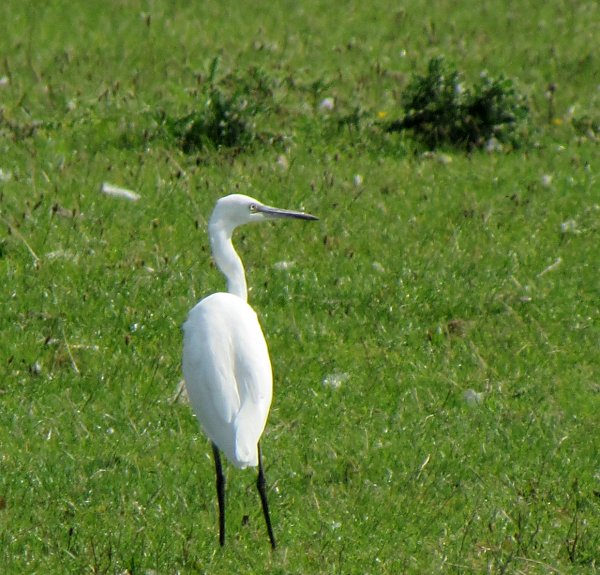 |
| Port Meadow Little Egret |
I got quite obsessive about checking the Bird Guides site so when a few days later a couple of Pectoral Sandpipers were reported on the Meadow I went straight down there to take a look. I dug up my old Boots 8x30 bins and went down to the Meadow where I met the original finder of the birds who soon put me on to them.
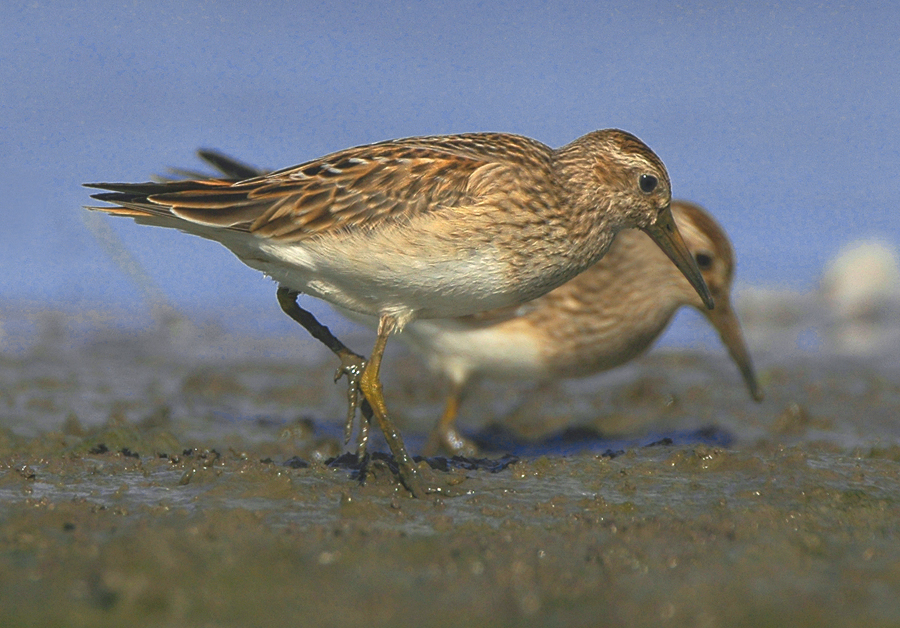 |
| The Pectoral Sandpipers (c) Steve Walton (the original finder) |
It was a particularly good autumn on the Meadow with a Grey Phalarope turning up and the Pec Sands staying a good while. What with the floods being around the whole time there were plenty of waders to look at and to try and get my head around. I remember stringing quite a few ID's back then ("what's new" I hear you say!) but keenly reporting them all on Bird Guides nonetheless. I joined the OOS and went along to some of the talks. I got myself some better bins and my first scope which was some useless Opticron budget scope which lasted all of a few months before I decided to get a Swaro. Gradually I got to know people in the county, and a very friendly and welcoming bunch they were too. My birding started to improve and I got into blogging when I set up the Port Meadow Birding blog as an outlet for my new-found enthusiasm for this hobby. Things progressed and I now find that I can't imagine life without birding.
Looking back, if I hadn't been living next to Port Meadow, and the floods hadn't been there all summer and the birding particularly good that summer then I don't think that it would have happened. Somehow though, all these things came into alignment to bring me in from the cold and back to birding.
Looking back, if I hadn't been living next to Port Meadow, and the floods hadn't been there all summer and the birding particularly good that summer then I don't think that it would have happened. Somehow though, all these things came into alignment to bring me in from the cold and back to birding.
Calling all 'Birdsworths'
Have you a birding tale to tell? A story of birding daring do, an EPIC twitch or simply a story of an encounter with one of our feathered friends. If so we would love to hear from you...
- Farmoor Reservoir: 4th June
Ringed Plover today at Farmoor courtesy of Jim Hutchins ...
- Otmoor.a.m. 16th October.
Bittern (per John Reynolds) ...
- Redwings 14th October
Courtesy of Paul Chandler more at Cholsey Wildlife Redwing 120 Middleton Cheney (M.H) ...
- Otmoor 22nd September
Hen Harrier (ringtail) Ashgrave 17:20 Then over the reed beds 17:40 & 18:40 ...
- Otmoor. Evening.
Shelduck. (juv.)From the Bridleway. Marsh Harrier. 1 Hobby (per Joe...
